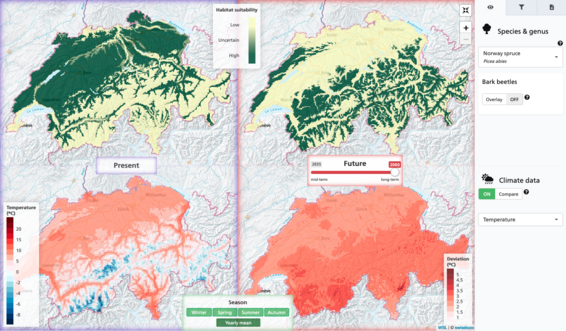

Over the past years, the need for reliable information about the current forest condition and potential future developments has grown in Switzerland. The Swiss Federal Research Institute WSL meets this need with data collected or modelled at various temporal and spatial scales – from the stem growth of trees measured at a 10-minute interval to regional canopy moisture derived from satellite data. Most of these results have been available online, some of them in real time.
This wealth of data has now been aggregated by WSL into user-friendly tools, FORTE (short for Forest Tree Explorer) and FORTE Future. The tools are the core of the new thematic module “Forest services and climate” of the Swiss National Center for Climate Services (NCCS – see box). They address both the current state of the Swiss forests (FORTE) and their long-term development (FORTE Future).
For example, FORTE (fig. 1) displays the current water stress and growth of 400 trees in real time or the current defoliation level of more than 1000 trees all over Switzerland. Users can combine these data in various ways, from local to national level, and superimpose data at forest level such as soil dryness, canopy moisture, or the number of bark beetle generations currently present. The displayed data are available for download as a comprehensive summary with graphs and additional information.
The second tool, FORTE Future, maps the habitat suitability of over 30 tree species in Switzerland and their potential distribution in the present and in the mid- or long-term future. It clearly shows that with the expected higher temperatures and much reduced summer precipitation, there will be losers (such as Norway spruce in figure 2) but also winners (e.g. sessile oak and pedunculate oak).
In addition to these tools, the NCCS web site conveys four key messages using fictional narratives: three forest users (Figure 3) highlight potential impacts of climate change on protective forest and recreational forests, as well as on timber production. The fourth character, a forest researcher, introduces approaches that can make forests more climate-resilient in the future. Together, these narratives aim to show that the Swiss population is already being affected in very concrete ways by the impacts of climate change on forest ecosystem services, and will be even more affected in the future.
(Kopie 4) ¶
Links ¶
Further information is available in our press release of December 16, 2021.